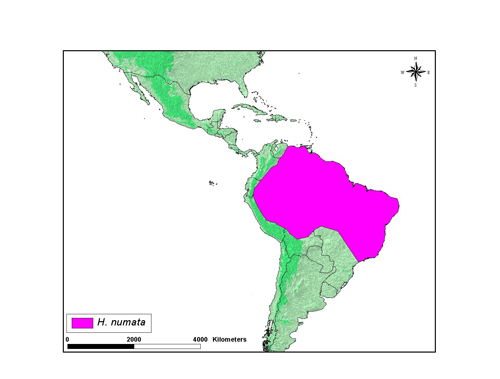Heliconius numata
Margarita BeltránCharacteristics
Early stages: Eggs are yellow and approximately 1.4 x 0.9 mm (h x w). Females usually place 1 to 2 eggs on growing shoots and tendrils of the host plant. Mature larvae have a white body and black spots, black scoli, and head and anal cap are orange; length is around 2 cm. Caterpillars are gregarious in small numbers (Brown, 1981).
Geographical Distribution
Heliconius numata is distributed from Venezuela to South Brazil. The map below shows an approximate representation of the geographic distribution of this species. The original data used to draw these maps are derived from Brown (1979) which is available at Keith S. Brown Jr. (1979). Ecological Geography and Evolution in Neotropical Forests.
Habits
H. numata occurs from sea level to 1,800 m in tall forests. Usually individuals fly rapidly in the middlestory. Females mate multiply and adults roost solitarily or in small groups at night at 2-10 m above ground on twigs or tendrils.
Hostplant: H. numata larvae feed primarily on plants from the subgenera Granadilla, Astrophea and Distephana (Passifloraceae) and from the genera Dilkea and Tetrastylis (Brown, 1981).
References
Brown K. S. 1981 The Biology of Heliconius and Related Genera. Annual Review of Entomology 26, 427-456.
Cramer, Pieter [1721_1776] 1780. De uitlandische Kapellen voorkomende in de drie Waereld-Deelen Asia, Africa en America. Papillons exotiques des trois parties du monde l'Asie, l'Afrique et l'Amérique. Amsteldam, S. J. Baalde; Utrecht, Barthelemy Wild and J. Van Schoonho-ven & Comp. 4(25/26): 1-28, pls. 289-304.
Information on the Internet
- Mathieu Joron homepage. Information about genetics and mimicry in Heliconius numata.
Title Illustrations

| Scientific Name | Heliconius numata silvana |
|---|---|
| Specimen Condition | Dead Specimen |
| View | Dorsal |
| Collection | Gerardo Lamas |
| Image Use |
 This media file is licensed under the Creative Commons Attribution-NonCommercial-ShareAlike License - Version 3.0. This media file is licensed under the Creative Commons Attribution-NonCommercial-ShareAlike License - Version 3.0.
|
| Copyright |
©

|
| Scientific Name | Heliconius numata silvana |
|---|---|
| Specimen Condition | Dead Specimen |
| View | Ventral |
| Collection | Gerardo Lamas |
| Image Use |
 This media file is licensed under the Creative Commons Attribution-NonCommercial-ShareAlike License - Version 3.0. This media file is licensed under the Creative Commons Attribution-NonCommercial-ShareAlike License - Version 3.0.
|
| Copyright |
©

|
| Scientific Name | Heliconius numata bicoloratus |
|---|---|
| Specimen Condition | Dead Specimen |
| View | Dorsal |
| Collection | Gerardo Lamas |
| Image Use |
 This media file is licensed under the Creative Commons Attribution-NonCommercial-ShareAlike License - Version 3.0. This media file is licensed under the Creative Commons Attribution-NonCommercial-ShareAlike License - Version 3.0.
|
| Copyright |
©

|
| Scientific Name | Heliconius numata bicoloratus |
|---|---|
| Specimen Condition | Dead Specimen |
| View | Ventral |
| Collection | Gerardo Lamas |
| Image Use |
 This media file is licensed under the Creative Commons Attribution-NonCommercial-ShareAlike License - Version 3.0. This media file is licensed under the Creative Commons Attribution-NonCommercial-ShareAlike License - Version 3.0.
|
| Copyright |
©

|
| Scientific Name | Heliconius numata tarapotensis tarapotensis |
|---|---|
| Specimen Condition | Dead Specimen |
| View | Dorsal |
| Collection | Gerardo Lamas |
| Image Use |
 This media file is licensed under the Creative Commons Attribution-NonCommercial-ShareAlike License - Version 3.0. This media file is licensed under the Creative Commons Attribution-NonCommercial-ShareAlike License - Version 3.0.
|
| Copyright |
©

|
| Scientific Name | Heliconius numata tarapotensis tarapotensis |
|---|---|
| Specimen Condition | Dead Specimen |
| View | Ventral |
| Collection | Gerardo Lamas |
| Image Use |
 This media file is licensed under the Creative Commons Attribution-NonCommercial-ShareAlike License - Version 3.0. This media file is licensed under the Creative Commons Attribution-NonCommercial-ShareAlike License - Version 3.0.
|
| Copyright |
©

|
About This Page

University of Cambridge, Cambridge, UK
Correspondence regarding this page should be directed to Margarita Beltrán at
Page copyright © 2010
 Page: Tree of Life
Heliconius numata .
Authored by
Margarita Beltrán.
The TEXT of this page is licensed under the
Creative Commons Attribution-NonCommercial-ShareAlike License - Version 3.0. Note that images and other media
featured on this page are each governed by their own license, and they may or may not be available
for reuse. Click on an image or a media link to access the media data window, which provides the
relevant licensing information. For the general terms and conditions of ToL material reuse and
redistribution, please see the Tree of Life Copyright
Policies.
Page: Tree of Life
Heliconius numata .
Authored by
Margarita Beltrán.
The TEXT of this page is licensed under the
Creative Commons Attribution-NonCommercial-ShareAlike License - Version 3.0. Note that images and other media
featured on this page are each governed by their own license, and they may or may not be available
for reuse. Click on an image or a media link to access the media data window, which provides the
relevant licensing information. For the general terms and conditions of ToL material reuse and
redistribution, please see the Tree of Life Copyright
Policies.
- First online 18 February 2007
- Content changed 12 August 2008
Citing this page:
Beltrán, Margarita. 2008. Heliconius numata . Version 12 August 2008 (under construction). http://tolweb.org/Heliconius_numata/72894/2008.08.12 in The Tree of Life Web Project, http://tolweb.org/







 Go to quick links
Go to quick search
Go to navigation for this section of the ToL site
Go to detailed links for the ToL site
Go to quick links
Go to quick search
Go to navigation for this section of the ToL site
Go to detailed links for the ToL site